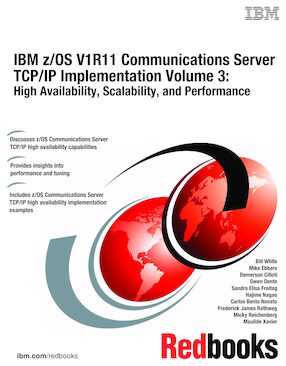IBM z/OS V1R11 Communications Server TCP/IP Implementation Volume 3: High Availability, Scalability, and Performance
An IBM Redbooks publication
Note: This is publication is now archived. For reference only.

Published on 22 February 2010
ISBN-10: 073843390X
ISBN-13: 9780738433905
IBM Form #: SG24-7800-00
Authors: Bill White, Mike Ebbers, Demerson Cilloti, Gwen Dente, Sandra Elisa Freitag, Hajime Nagao, Carlos Bento Nonato, Frederick James Rathweg, Micky Reichenberg, Maulide Xavier and Thanks to the following people
For more than 40 years, IBM® mainframes have supported an extraordinary portion of the world's computing work, providing centralized corporate databases and mission-critical enterprise-wide applications. The IBM System z®, the latest generation of the IBM distinguished family of mainframe systems, has come a long way from its IBM System/360 heritage. Likewise, its IBM z/OS® operating system is far superior to its predecessors, providing, among many other capabilities, world-class, state-of-the-art, support for the TCP/IP Internet protocol suite.
TCP/IP is a large and evolving collection of communication protocols managed by the Internet Engineering Task Force (IETF), an open, volunteer, organization. Because of its openness, the TCP/IP protocol suite has become the foundation for the set of technologies that form the basis of the Internet. The convergence of IBM mainframe capabilities with Internet technology, connectivity, and standards (particularly TCP/IP) is dramatically changing the face of information technology and driving requirements for ever more secure, scalable, and highly available mainframe TCP/IP implementations.
The IBM z/OS Communications Server TCP/IP Implementation series provides understandable, step-by-step guidance about how to enable the most commonly used and important functions of z/OS Communications Server TCP/IP.
In this IBM Redbooks® publication, we begin with a discussion of Virtual IP Addressing (VIPA), a TCP/IP high-availability approach that was introduced by the z/OS Communications Server. We then show how to use VIPA for high availability, both with and without a dynamic routing protocol. We also discuss a number of different workload balancing approaches that you can use with the z/OS Communications Server. We also explain the optimized Sysplex Distributor intra-sysplex load balancing. This function represents improved multitier application support using optimized local connections together with weight values from extended Workload Manager (WLM) interfaces. Finally, we highlight the most important tuning parameters and suggest parameter values that we observed to maximize performance in many client installations.
For more specific information about z/OS Communications Server base functions, standard applications, and security, refer to the other volumes in the series:
-- IBM z/OS V1R11 Communications Server TCP/IP Implementation Volume 1: Base Functions, Connectivity, and Routing, SG24-7798
-- IBM z/OS V1R11 Communications Server TCP/IP Implementation Volume 2: Standard Applications, SG24-7799
-- IBM z/OS V1R11 Communications Server TCP/IP Implementation Volume 4: Security and Policy-Based Networking, SG24-7801
For comprehensive descriptions of the individual parameters for setting up and using the functions described in this book, along with step-by-step checklists and supporting examples, refer to the following publications:
-- z/OS Communications Server: IP Configuration Guide, SC31-8775
-- z/OS Communications Server: IP Configuration Reference, SC31-8776
-- z/OS Communications Server: IP User's Guide and Commands, SC31-8780
This book does not duplicate the information in those publications. Instead, it complements them with practical implementation scenarios that can be useful in your environment. To determine at what level a specific function was introduced, refer to z/OS Communications Server: New Function Summary, GC31-8771. For complete details, we encourage you to review the documents referred to in "Related publications" on page 303.
Chapter 1. Introduction to z/OS Communications Server high availability technologies
Chapter 2. Virtual IP addressing
Chapter 3. VIPA without dynamic routing
Chapter 4. VIPA with dynamic routing
Chapter 5. Internal application workload balancing
Chapter 6. External application workload balancing
Chapter 7. Intra-sysplex workload balancing
Chapter 8. Performance and tuning
Appendix A. HiperSockets Multiple Write
Appendix B. Our implementation environment